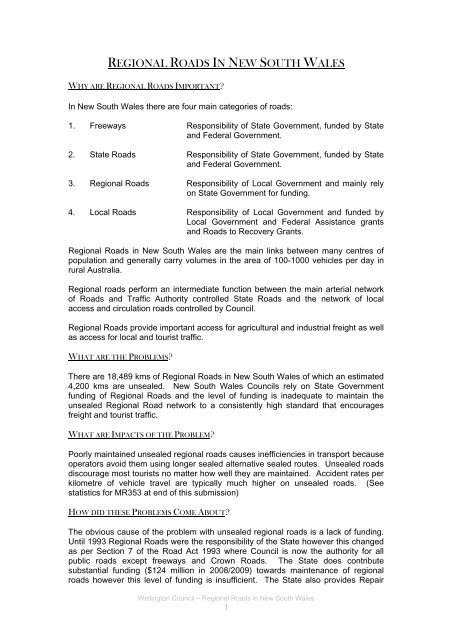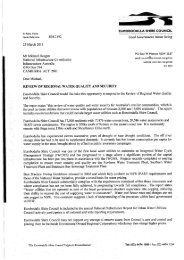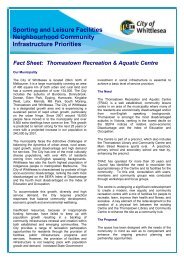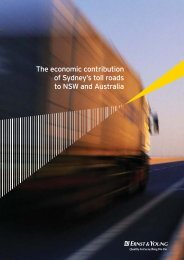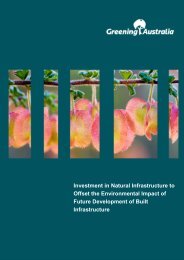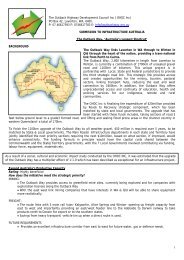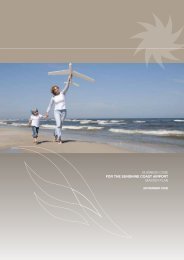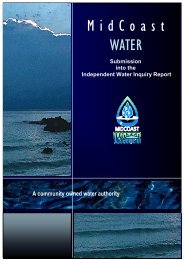REGIONAL ROADS IN NEW SOUTH WALES - Infrastructure Australia
REGIONAL ROADS IN NEW SOUTH WALES - Infrastructure Australia
REGIONAL ROADS IN NEW SOUTH WALES - Infrastructure Australia
Create successful ePaper yourself
Turn your PDF publications into a flip-book with our unique Google optimized e-Paper software.
<strong>REGIONAL</strong> <strong>ROADS</strong> <strong>IN</strong> <strong>NEW</strong> <strong>SOUTH</strong> <strong>WALES</strong>WHY ARE <strong>REGIONAL</strong> <strong>ROADS</strong> IMPORTANT?In New South Wales there are four main categories of roads:1. Freeways Responsibility of State Government, funded by Stateand Federal Government.2. State Roads Responsibility of State Government, funded by Stateand Federal Government.3. Regional Roads Responsibility of Local Government and mainly relyon State Government for funding.4. Local Roads Responsibility of Local Government and funded byLocal Government and Federal Assistance grantsand Roads to Recovery Grants.Regional Roads in New South Wales are the main links between many centres ofpopulation and generally carry volumes in the area of 100-1000 vehicles per day inrural <strong>Australia</strong>.Regional roads perform an intermediate function between the main arterial networkof Roads and Traffic Authority controlled State Roads and the network of localaccess and circulation roads controlled by Council.Regional Roads provide important access for agricultural and industrial freight as wellas access for local and tourist traffic.WHAT ARE THE PROBLEMS?There are 18,489 kms of Regional Roads in New South Wales of which an estimated4,200 kms are unsealed. New South Wales Councils rely on State Governmentfunding of Regional Roads and the level of funding is inadequate to maintain theunsealed Regional Road network to a consistently high standard that encouragesfreight and tourist traffic.WHAT ARE IMPACTS OF THE PROBLEM?Poorly maintained unsealed regional roads causes inefficiencies in transport becauseoperators avoid them using longer sealed alternative sealed routes. Unsealed roadsdiscourage most tourists no matter how well they are maintained. Accident rates perkilometre of vehicle travel are typically much higher on unsealed roads. (Seestatistics for MR353 at end of this submission)HOW DID THESE PROBLEMS COME ABOUT?The obvious cause of the problem with unsealed regional roads is a lack of funding.Until 1993 Regional Roads were the responsibility of the State however this changedas per Section 7 of the Road Act 1993 where Council is now the authority for allpublic roads except freeways and Crown Roads. The State does contributesubstantial funding ($124 million in 2008/2009) towards maintenance of regionalroads however this level of funding is insufficient. The State also provides RepairWellington Council – Regional Roads in New South Wales1
Funding ($25.3 million in 2008/2009) towards reconstructing and extending seals onregional roads however this does not address the large shortfall in funding.HOW MIGHT THE PROBLEM BE ADDRESSED?Local and State Governments require assistance to improve the condition ofunsealed regional roads and to improve their level of service and safety by sealingthem.Given there are 4,200 kms of unsealed Regional Roads in New South Wales and onthe premise that 25% of these roads merit sealing over the next ten years at anaverage cost of $350,000 per kilometre, an investment of $37 million per annumwould achieve this goal over the ten years period.WHAT SHOULD BE DONE FIRST?It is proposed that a Strategic Regional Roads Program evaluated against severalreasonable criteria would help to prioritise such as program to seal 25% of theunsealed Regional Roads in New South Wales over a ten year period.CASE <strong>IN</strong> PO<strong>IN</strong>TWELL<strong>IN</strong>GTON – NARRABRI <strong>REGIONAL</strong> ROAD PROJECTThe Wellington – Narrabri Regional Road Project is proposed as a specific roadproject worthy of funding under the National <strong>Infrastructure</strong> Program.The project was recognised under the Auslink Program and received Federal funding($6.65M) towards partial sealing and upgrading this important link. At the end of thisprogram in June 2010 there will be 28 kms of the project remaining unsealed and afurther 10 kms in need of urgent rehabilitation. The estimated cost to complete theproject is $12.5 million and the three involved Councils (Wellington, Warrumbungleand Gunnedah Councils) are prepared to significantly contribute towards the fundingof the project as they have in the current program.The benefits of Wellington – Narrabri project have been analysed in a detailed studycarried out by Peece consulting which is available on request.The keys aspects of the project are:• Total length of road from Wellington to Narrabri – 314.4 kms.• Length unsealed as of June 2010 – 28 kms• Current Traffic Volumes65 AADT (26% heavy vehicles) – 900 AADT (14% heavy vehicles).Wellington Council – Regional Roads in New South Wales2
• Accident Statistics(35-160 crashes per 100 million vehicles kilometres on unsealed sectionscompared to 10-20 on nearby Mitchell and Golden Highways.• Agricultural Business BenefitsGrain movements – 30,000 tonne per annum Wellington area – MR353Cotton movements – 14,000 tonne per annum Gunnedah area – RR7709Cattle movements – 1,500 truck per annum Gunnedah area – RR7709Plus significant sheep and fodder truck movements• Tourism BenefitsAllows tourists to leave Newell Highway at Parkes and travel an alternativebyway route to Narrabri on a quieter road relatively free of heavy vehicles.Smaller rural towns and villages including Yeoval, Wellington, Coolah,Boggabri, Tambar Springs and Mullaley will benefit from the additional Tourism.• Social Equity BenefitsProvide sealed access for local residents and businesses.• Benefit Cost RatioEstimated between 1.5 and 1.8Wellington Council – Regional Roads in New South Wales3


